
Medical Bits – Vol. 4.2: Your Health and Medical News
Medical News: “Endemic” COVID
As you all know, COVID cases are again on the rise everywhere. A more infectious variant of Omicron (BA.2.12.1) has taken over the nation and is more effective at sneaking past our natural and vaccine-induced defenses. Fortunately, most people have been vaccinated or have natural immunity which should lead to a milder surge in cases with fewer hospitalizations and severe disease.
As we discussed a few months ago, the first Pandemic of the XXI century is becoming a more “endemic” condition. Pandemics usually do not just disappear, but tend to fade away and become endemic in places with low vaccination rates with intermittent flare-ups. We now realize that even in places with high vaccination rates and high levels of immunity, periodic increases in viral activity and infection are becoming the norm. This is likely due to the highly infectious nature of these respiratory viruses, frequent mutations and waning antibody titers induced by vaccination and infection.
We also reviewed how the presence of very large animal reservoir (as more than 500 species of mammals have been infected and are likely to continue to recirculate the virus) may lead to occasional infections into the distant future and another reason why in my opinion, a “zero” Covid policy as ambitioned by China is unrealistic, particularly in light of the more infectious subvariants of Omicron.
This past week, the CDC released recommendations to wear well fitted masks while using public transport, hubs, or planes. As you recall updated guidelines in February 2022 suggested that more than 70% of counties could stop wearing masks indoors and emphasized three measures to assess risk: New Covid-related hospital admissions, proportion of beds occupied and new cases over the prior week. Lately, they have all been rising again.
COVID IS NOT GOING AWAY!
Almost 6 months after the Omicron variant was identified in Zimbabwe and South Africa, two “sons or daughters” offshoots of Omicron are again driving an upsurge in Covid cases there (and B2 variants here) and offer a glimpse of what may happen in the future.
The BA.2.12.1 (in the US) and the BA.4 and BA.5 Omicron variants are a bit more transmissible and may “dodge” some of the protections provided by prior infection and vaccination.
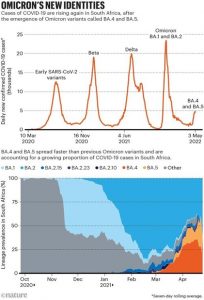
This chart provides information on what to expect going forward. You can see a periodic rise as new variants develop and encounter a susceptible population with waning antibody titers and lower “mucosal” protection.
These new BA.2 derived variants are better able to escape immunity, thus leading to another wave of infection as antibody neutralization is not as effective. The periodic rise of new coronavirus variants could lead to intermittent waves of infection and continue to drive an “endemic” disease such as Influenza.
We should emphasize that despite the higher infection rate, the high levels of natural immunity and vaccination rates will continue to provide protection against troublesome, severe disease. But best to be mentally and physically prepared for this “nuisance” which may continue to cause “background noise” and may become an occasional “companion”.
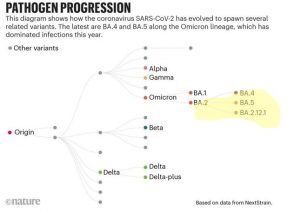
COVID-19 Mortality
The official Covid-19 world-wide deaths have reached 6.2 million (1 million in the U.S) but the excess-mortality data may be closer to 25 million, as updated last week by The Economist.
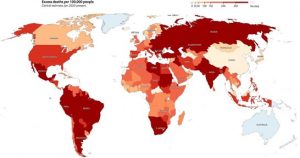
The discrepancy between “official” and “real” mortality data is due to lack of testing and accurate tallies. Review of excess mortality, provides a more accurate assessment.
Despite the big initial failures at containment, the developed world and science delivered effective and safe vaccines and several treatments to mitigate progressive disease and lethal outcomes for most humans.
VACCINES AND “BROAD SPECTRUM SHOTS”
As of late April 2022, almost 11.5 billion Covid-19 vaccine doses have been administered worldwide and by mid 2022 the WHO projects that 70% of the world population should be vaccinated.
A few months ago, we briefly discussed the international effort to develop a “Universal Coronavirus” vaccine or a “broad-spectrum” vaccine that may provide wide protection against several coronaviruses, including yet-unidentified strains. The huge diversity of bat coronaviruses, their proximity to humans and the high mutability of the spike gene essential for immune recognition, have prompted a large collaborative international effort to develop “pan-coronaviruses vaccines”.
An ongoing cloud computing infrastructure called Serratus is enabling and accelerating the analysis of millions of novel RNA viruses which can point to the origin and evolution of new dangerous viruses and improve our surveillance for mitigation of future pandemics.
These new broad vaccines in development display different viral antigens in diverse manners, such as Ferritin Nanoparticles, Mosaic Nanoparticles and Chimeric Spikes, among others as summarized here.
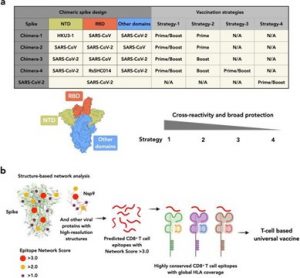
COVID-19 UPDATE
- Should we get a second booster – 4th shot? YES.
- Since protection against mild disease continues to decrease after 4-6 months (mucosal protection is mediated by virus-specific neutralizing antibodies), best to obtain another shot.
- If already infected in the past few months (most people), obtain second booster 3-4 months after infection.
- 4 vaccine-doses improves short term protection compared to 3 doses and decreases symptomatic disease, severe illness and hospitalizations.
- Another recent study from Qatar in 3 million people confirms findings.
- Mild disease or asymptomatic infection should not be considered “breakthrough” infection after vaccination. They should be expected.
- If older than 65 or with comorbid conditions, best to get a 4th shot.
- Risk/Benefit marginal for 15-30 year-old men (higher risk of pericarditis and myocarditis after vaccination).
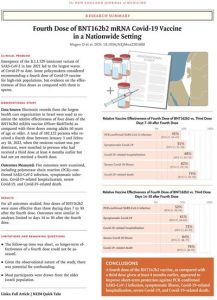
- The average new cases, hospitalizations and deaths again on the rise.
- The CDC released a new system in February 2022, to offer mitigation guidance county-by-county and adjusted weekly based on the number of new cases, hospital admissions and percentage of hospital beds occupied by Covid patients in each county weekly.
- CDC designates each county’s “Covid Level” as green (low), yellow (medium) and orange (high) with appropriate recommendations.
- HERE, you can find all the COVID-19 STATS and more.
- CDC study: Transmissibility of Omicron variant
- Omicron transmission occurred in 67.8% of households.
- The attack rate among contacts of index patients varied:
- Vaccinated with booster within 5 months: 42.7%
- Vaccinated without booster: 43.6%
- Unvaccinated index patients: 63.9%
- Maternal Vaccination during pregnancy protects infants against hospitalization for several months after birth.
- Of 176 infants admitted with COVID, 148 (84%) were born to unvaccinated mothers.
- Almost 90% of the infants requiring ICU care had unvaccinated mothers.
- Protection of vaccination greater if administered in the 3rd trimester. SAFE and EFFECTIVE.
- Sadly, irrational anti-vaxxers have misappropriated and linked few reports of miscarriages. FALSE.
- Compounds from Propolis and Honey improve symptoms
- Compounds from propolis and honey appear to interact with target proteins of SARS-CoV-2, interfering with viral entry and RNA replication improving symptoms and decreasing viral clearance time. 15 studies with small sample sizes.
- In Covid-19 pneumonitis, IV vitamin C administration does not improve disease severity or outcomes.
- Analysis of 7 studies did not demonstrate
- Vaccination reduces transmission.
- Among almost 150,000 tested contacts of 110,000 index patients in Britain, two doses of the Pfizer or A-Z vaccines reduced PCR positivity in contacts as compared with no vaccination.
- Smaller reduction in transmission of Delta variant.
- Efficacy decreased over time.
- Does infection with Omicron protect against other strains?
- This study published by the researchers that identified Omicron from South Africa, suggests that the degree of protection may be related to the vaccination status prior to infection.
- Vaccinated patients generated 3x anti-Omicron neutralizing antibodies,
- Priming the immune system with the original Spike protein antigen augments immunity to a new variant, even one as diverse as Omicron.
- Vaccinated patients generated a volume of neutralizing antibodies against other variants 15 to 150-fold higher than the unvaccinated.
- Lends additional support to why the vaccinated patients fare much better than the unvaccinated.
COVID-19 Variants and Mutants
Since the first SARS-CoV2 was sequenced in Wuhan on January 10th, 2020, more than 6.6 million SARS-CoV2 genomes have been added to the GISAID database and arranged into “clades” – groupings with a distinct common ancestor.
As Dr. Anthony Fauci and his colleagues from NIH-NIAID explain, over the past two decades humanity encountered four coronavirus epidemics – SARS 2002- 2003 – MERS and Covid-19. Due to loss of habitat and closer proximity to other mammals and bats in particular, additional coronaviruses are likely to emerge. The scientific community is working on characterizing the global coronavirus universe to use this information in the design of “universal” coronavirus vaccines.
There are several open-source databases tracking SARS-CoV-2 genomic sequences, but the largest and most popular is GISAID.
It was originally conceived in 2006 as a “bank” of genomic data from flu viruses, but the Pandemic has expanded its mission to promote the rapid sharing of data from all influenza and coronaviruses to help researchers understand how viruses evolve and spread during epidemics and pandemics. Scientists are able to upload the genomic sequence of the viral strain present in their communities. Their hard work has led to the sharing of more than 8 million coronavirus genome sequences from 183 nations, allowing researchers to track the development and movement of new variants across the planet. Nextstrain, is another open-source consortium that follows numerous infectious diseases and updated several times weekly, tracking the global spread and flow of variants.
The frequently updated Coronavirus Vaccine Tracker from the NYT is an excellent resource. Another from Nature. Also: Vaccine information.
COVID-19 Q & A: Please, refer to prior Bits.
- Should we get a second booster – 4th shot? YES.
- Since protection against mild disease continues to decrease after 4-6 months (mucosal protection is mediated by virus-specific neutralizing antibodies), best to obtain another shot.
- If already infected in the past few months (most people), obtain second booster 3-4 months after infection.
- I am fully vaccinated and now infected again. What to do?
- If mild symptoms, normal oxygenation and fever below 102, home remedies and symptomatic treatment should suffice.
- If high fevers and severe symptoms, or at high risk of complications, consider Paxlovid Same excellent results if initiated within 5 days of symptoms onset.
- For how long do I remain infectious after acute infection?
- Usually no more than 5 days after symptoms onset and 3 days after resolution of fever, even if Rapid test or PCR are likely to remain positive.
- Use precautions for 10 days after acute infection.
COVID-19 TREATMENTS
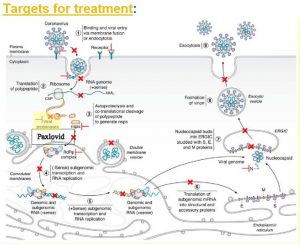
New oral treatments
- Paxlovid (Nirmatrelvir+Ritonavir) is effective against COVID-19 hospitalization or death.
- Paxlovid is an oral combination antiviral that blocks a viral protease (3CL) enzyme essential for viral replication.
- Effective against all variants to-date.
- Symptomatic, unvaccinated and high-risk Covid + adults were given Paxlovid or placebo twice daily x 5 days within 3 days of symptom onset.
- Paxlovid: 5/697 required hospitalization (0.72%) and 0 died.
- Placebo 44/682 required hospitalization (6.45%) and 9 died (1.32%).
- Similar results among those who started therapy within 5 days.
- 10-fold decrease in viral load at day 5 relative to placebo and therefore anticipated to decrease infectivity.
- Most common side-effect: transient change in taste perception 5%.
- Very safe. Check here for common drug-drug interaction.
- And check here to locate pharmacies with stock
- Molnupiravir
- Antiviral developed by the Emory Institute for Drug Development, made by Merck and active against influenza and many other RNA viruses.
- In a trial published in December, 800 mg administered twice daily for 5 days and initiated within 5 days of symptoms onset, decreased the risk of hospitalization or death from 14 to 7% on interim analysis but from a more modest 9.7% to a 6.8% with an absolute difference of 3% on final analysis.
COVID-19 Monoclonal Antibodies
Monoclonal antibodies are expensive engineered human monoclonal antibodies specific against the Spike protein of SARS-CoV2 and have been investigated to prevent progression of mild-moderate Covid-19 infection in ambulatory, UNVACCINATED patients (post-exposure prophylaxis) and for pre-exposure prevention in patients with moderate to severe immunocompromise, unable to mount a good response to vaccination. Since Paxlovid is now available, the use of these agents is anticipated to decrease.
There are many formulations and some trials have shown lower viral loads, and modestly lower rates of progression of disease.
- Bebtelovimab retains efficacy against Omicron and variants. 175 mg IV in > 12 yrs-old only when Paxlovid not available in high-risk individuals.
- Bamlanivimab is ineffective against the Delta or Omicron variants.
- Banlanivimab – Etesevimab are not effective against new variants.
- Casirivimab-Imdevimab combination retained efficacy against Delta but not against Omicron.
- Sotrovimab, which neutralizes most sarbecoviruses is effective against Omicron and the 500 mg may be administered as an infusion or intramuscular but Bebtelovimab recommended as first line.
- Tixagevimab / Cilgavimab (Evusheld) is effective for pre-exposure prophylaxis in moderately to severely immunocompromised hosts unable to mount a good response to vaccination and not a substitute to vaccination.
- 300/300 mg IM injections every 3 months.
COVID-19 – PROVEN THERAPY
NIH has a wonderful resource summarizing the evidence in their NIH Covid- Treatment Guidelines (now > 400 pages). Another review: Open Critical Care (also in Spanish).
In summary:
- Use Dexamethasone at 6 mg daily for 10 days after diagnosis of COVID-related pneumonitis / pneumonia
- Remdesivir: marginal benefit. Early oral formulation may be beneficial.
- In hospitalized patients, use IV Tocilizumab.
- If Tocilizumab not available use Sarilumab IV
- Ivermectin. NO EVIDENCE. Do not use. Now we know that it may be beneficial in lower- and middle-income nations where intestinal parasites are more prevalent, since the regular use of dexamethasone as part of the treatment may promote parasitic hyper-infection and infestation with bad pulmonary consequences. Effective against lice, scabies, filariasis and intestinal parasites!
- Azithromycin and Ceftriaxone have no benefit.
- Convalescent plasma – Ab from previously infected patients: No benefit.
- Plasma exchange – plasmapheresis. No benefit, costly and invasive
- Colchicine. Insufficient Do not use
- Interleukin 1 – 6 inhibitors. Insufficient Do not use.
- Janus Kinase Inhibitor Baricitinib. Possibly beneficial in the right setting.
- Anticoagulants. Only in prophylactic doses
- Supplements: Vitamin D, C, No benefit.
- High-Flow O2 in severe Covid-19 reduces intubation and time to recovery
YOUR HEALTH: WEIGHT LOSS
Are you overweight or obese? Here is your calculator
The association between rising weight with higher morbidity and mortality is beyond dispute and has been documented since the times of Hippocrates, who, from his island of Kos, launched the “medicine of observation” that we continue to value today.
More than two thirds of Americans are overweight or obese and other nations are catching up fast! Even in China 30% of adults are now fat.
The problem appears to be quite simple. Thermodynamics 101: Calories in > Calories out. But the problem is more complicated, as biology has evolved to ascertain survival. Human biology is no different. We favor salt, fat and sweets and naturally tend to store energy in fat stores should we suffer famine!
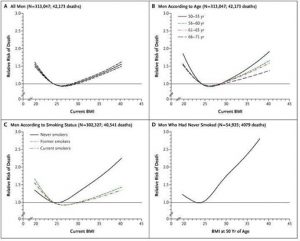
In fact, sugar can be a substance of abuse and lead to a natural form of addiction. “Food addiction” seems plausible as brain pathways that evolved to respond to natural rewards are also activated by sugar intake, leading to release of opioids and dopamine in the brain pleasure centers and thus, it might be expected to have addictive potential. I invite you to read this review.
Our modern world also conspires against our best efforts, as “junk food” is tasty and cheap! It is estimated that 20% of the weight gain over the past few decades is due to sugary drinks! And technology has automated jobs, provided ubiquitous “pocket screens” and reduced our energy expenditure leading to a positive caloric balance and rising fat with a progressive increase in our waist line, unless we remain vigilant and actively avoid it.
Obesity (and Type II Diabetes Mellitus) is more common in Native Americans, African Americans, Hispanics and Asian Americans than in the general population. And you are well aware that the rising weight of Humanity, has led to insulin resistance, type II DM and the development of another ongoing “pandemic” which has been worsening for the past 50-60 years, as discussed in prior “BITS”.
Reviewing the fascinating and infamous history of sugar would probably take many weeks, but briefly, after the domestication of the sugarcane plant in Southeast Asia some 6000 years ago, most of the cultivation and trade originated in India, the Islamic world and finally the Portuguese promoted their exploitation in the Madeira Isles. Upon discovery of the “New World” the tropical conditions suitable for their cultivation and the intensive nature of the crop requiring grueling labor promoted the slave trade and another dark chapter of history.
Sugar is the most popular ingredient added to foods in the US. One teaspoon of white sugar has 15 calories, but one teaspoon of corn syrup has 20 calories and soft drinks are responsible for most of the added sugar in the average American diet. One can of soda contains 11 teaspoons of sugar!

Two hundred years ago, the average American ate 2 pounds of sugar annually. Today, almost 152 pounds of per year!
Of course, limiting sugary drinks and decreasing the availability of high caloric food-sources in schools by the Obama Administration was “an overreach of power by the Federal Government and an attempt to curve civil liberties”. Just like the support of End-of-Life discussions by the ACA were labeled “death squads” by those opposed. You realize how difficult it is to make rational decisions that may help our society and our common goals when disinformation permeates our daily discourse.
But we can all agree that when at your supermarket, steer clear of any “food” that your mother or grandmother could not have recognized! Limit processed and artificial junk and anything that has excessive carbohydrates!
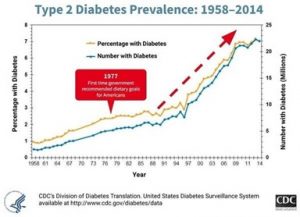
We know that lifestyle interventions, such as weight loss of 5-7% of body weight and adding 150 minutes of exercise weekly, reduce the risk of Diabetes by almost 60% overall (and by over 70% for people over 60).
My educated patients would not be surprised to learn that the food and beverage industry has laboriously opposed government efforts throughout the world to regulate and limit the amount of free-sugar consumption for many decades. And as we reviewed in the past, this is not an exceptional skirmish in our “mature” societies. The Tobacco Industry fought and continues to undermine efforts to regulate tobacco products despite the millions of humans who die or suffer daily as a result of their manufacture. And the Gun Industry and their lobbying groups continue to assault their regulatory demise with historical and grandiloquent references to that mystical document called Constitution (Now under further assault). As if those ambitious pages were not the consequence of arduous debates and opposite view-points that should be interpreted with historical perspective, taking into account the realities of agrarian 18th century communities and arguably need updating, to fulfill the needs of a modern urban society with millions of citizens living in close proximity, where “civility” is paramount.
How can we effectively lose weight?
There is so much written about this and so many billions “on the line”. This is just a succinct reminder
- Life-Style Modifications: Diet – Exercise – Behavior Modification
- Diets
- Balanced low-calorie diets – Mediterranean – DASH.
- Low-fat diets
- Low-carbohydrate and low glycemic index diets
- High-protein diets
- Exercise
- Combined aerobic – resistance exercise works best.
- Diets
- Devices
- Laparoscopic adjustable gastric banding
- Electrical stimulation (vagal blockade) systems
- Intragastric balloon systems
- Gastric emptying aspiration systems
- Hydrogels
- Bariatric surgery (numerous designs, now mostly sleeve gastrectomy).
- Liposuction (do not consider!).
- Drug therapy
As you may recall, medications for weight loss have a troubling history with withdrawal of several approved drugs after adverse events became evident. Among them, several amphetamines (noted to cause addiction), fenfluramine (pulmonary hypertension and cardiac toxicity) and more recently lorcaserin (increased cancer risk).
Available drugs include the lipase inhibitor Orlistat (reduces intestinal fat absortion), phentermine-topiramate (Qsymia) and naltrexone-bupropion. They have equivocal efficacy, significant side effects, and do not prevent or treat Type II Diabetes Mellitus.
Fortunately, new medications approved for treatment of Type II Diabetes have been shown to be associated with significant and sustained weight loss with good safety and acceptable side-effects.
The glucagon-like peptide-1 agonist Semaglutide in particular, is a good option as it requires a weekly subcutaneous injection. It may cause nausea, vomiting and diarrhea (occasionally constipation). There are other drugs in this family that require a daily injection and one oral version is available as well. More in development.
Let’s remember that not losing weight and maintaining an unhealthy waist line is itself associated with poor outcomes in the long-run. Health, to a large degree, is our personal responsibility.
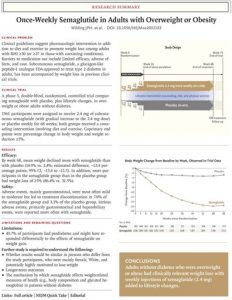
If you have 7 minutes daily, you can start to improve your fitness right now with the Scientific 7- Minute Workout. Get the app on your phone! 11 more minutes will get you in shape! For core strength, try this 9-minute routine!
AND START EXPLORING AND PRACTICING MINDFULNESS! It will also help you lower your blood pressure and levels of stress. It will raise pain threshold and your overall sense of well-being. THERE ARE MULTIPLE RESOURCES ON THE WEB.
Let’s all remember that the only certainty in life, is death and the only fountains of youth proven by science and experience are love, exercise, laughter, humor and a positive attitude!
OFFICE UPDATES
- My assistant, Simran Singh, will leave in mid-July, to pursue her dream at University of Buffalo, Jacobs School of Medicine.
- Olivia Dragovits (oliviad@chevychasepulmonary.com) will try to fill her BIG shoes and be ready to assist with your needs.
- Sarah Molinari has decided to move back to her native Florida and continue to feed the dwindling Manatees (where we may help upon retirement).
- Fiona MacNair is joining the Peace Corps and will spend two years in remote rural Namibia to improve the lot of their children.
- Erik Savereide will leave in mid-July to become a physician at the University of Michigan in Ann Arbor.
- Samantha Morales is waiting to hear back from Medical Schools
- I will be away visiting family in Argentina from June 10th-21st and a late summer vacation from August 26th– September 4th, but never far from email and phone. My partners will cover emergencies in my absence as usual.
Wishing you a Happy Summer!
Carlos E. Picone, MD
5215 Loughboro Rd NW, Suite 400
Washington, DC 20016
301-656-7374